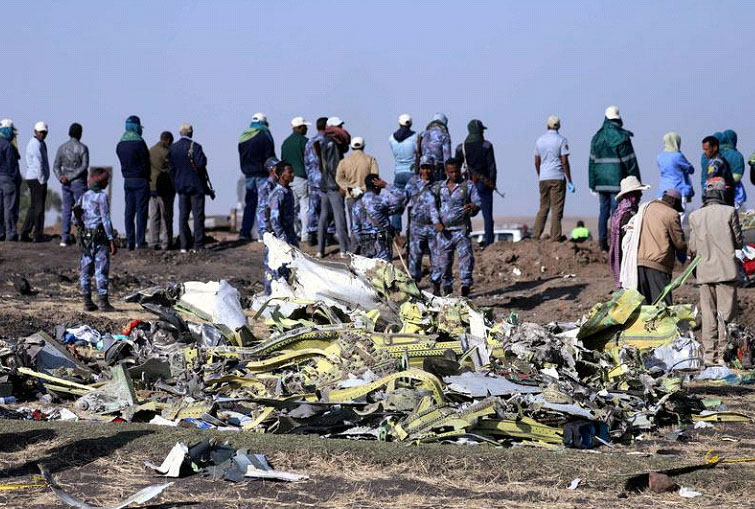ADDIS ABABA/SEATTLE, (Reuters) – Faulty sensor readings and multiple automatic commands to push down the nose of a Boeing plane contributed to last month’s fatal crash in Ethiopia, leaving the crew struggling to regain control, according to a preliminary accident report.
The first substantial account of the last minutes of Ethiopian Airlines flight 302 from Addis Ababa to Nairobi on March 10 described how the captain three times called out: “Pull up” and was acknowledged by the first officer, but to no avail.
Boeing’s top-selling aircraft, the 787 MAX, has been grounded worldwide since the March 10 disaster, which killed 157 people and came just five months after a Lion Air crash in Indonesia that killed 189 in a plane of the same model.
Families of the victims, regulators and travellers around the world have been waiting for signs of whether the two crashes are linked, and the extent to which Boeing technology and the actions of the Ethiopian Airlines pilots played a role.
The doomed flight crashed six minutes after take-off from Addis Ababa in clear conditions. “Most of the wreckage was found buried in the ground,” said the report by the Ethiopian Civil Aviation Authority’s Accident Prevention and Investigation Bureau published on Thursday.
It recommended that Boeing review its flight-control systems and that regulators properly verify the review.
Ethiopian Transport Minister Dagmawit Moges told a news conference in the Ethiopian capital the crew had performed all the procedures recommended by Boeing, but safety experts said this was likely to spark debate with U.S. regulators and Boeing.
Boeing said its coming software fix for the anti-stall system that pushes down the plane’s nose would give pilots the authority to always override the system if activated by faulty sensor data.
“I’d like to reiterate our deepest sympathies are with the families and loved ones of those who lost their lives in the accident,” said Boeing Commercial Airplanes President and Chief Executive Kevin McAllister.
“We will carefully review the AIB’s preliminary report, and will take any and all additional steps necessary to enhance the safety of our aircraft.”
The report leaves unanswered questions, some experts said, such as why the plane’s trajectory did not respond to pilot and automatic commands including two final nose up commands from the pilots about 30 seconds before the plane crashed.
“Those should literally follow each other,” said one U.S.-based expert, speaking on condition of anonymity because of the sensitivity of the matter. “I think this is a more complex problem than what we initially thought.”
Questions have also been raised over whether crew followed guidance not to restore power to a troublesome anti-stall system following the sensor damage, possibly caused by a bird strike. The plane was also set to unusually high thrust, data suggested.
A final report by Ethiopian authorities aided by air-safety experts from the United States and Europe is due to be published within a year.
Some pilots expressed disquiet that following Boeing’s checklist for the malfunction had not appeared to work.
“If the preliminary report from the Ethiopian authorities is accurate, the pilots quickly identified the malfunction and applied the manufacturer’s checklist. Following this checklist did not appear to allow the pilots to regain control of the aircraft,” said Captain Jason Goldberg, spokesman for Allied Pilots Association, which represents American Airlines pilots.
The Federal Aviation Administration, which has come under fire over the way it decided to certify the plane and its so-called MCAS anti-stall software, cautioned the investigation had not yet concluded.
“We continue to work towards a full understanding of all aspects of this accident. As we learn more about the accident and findings become available, we will take appropriate action,” the U.S. agency said in a statement.
Southwest Airlines Co and American Airlines Group Inc, the two largest U.S. operators of the MAX with 34 and 24 jets respectively and dozens more on order, each said on Thursday that they continued to await guidance from U.S. regulators and Boeing on when the MAX could resume flying.
Ethiopian investigators did not blame anyone for the crash, stressing the importance of international rules requiring civil probes to focus on recommendations for safer flight.
Most accidents take months of analysis because of the need to trace backwards to find a root cause from tangled evidence.
“There is a big difference between having the data and knowing the cause,” a senior European investigator said.
Officials denied reports of tensions between Ethiopian officials and U.S. and other foreign investigators accredited to the probe.
“We don’t have any reservations from different stakeholders who were engaged in the investigations,” chief investigator Amdye Ayalew Fanta said.
Following a previous Ethiopian Airlines accident off Beirut in 2010, Addis Ababa authorities rejected the conclusions of a Lebanese investigation citing pilot error and suggested the aircraft had exploded in a possible act of sabotage.
Aviation safety analyst Paul Hayes said deeper investigation would delve into the role played by software and how pilots were able to respond, and said he hoped scars from the 2010 dispute would not get in the way of a comprehensive investigation.
“Pilots shouldn’t have to cope with such an emergency situation. We need to understand what are the factors that meant these two crews were overcome,” said Hayes, safety director at UK-based consultancy Flight Ascend.
“It is unusual for there to be a single cause,” he added.






